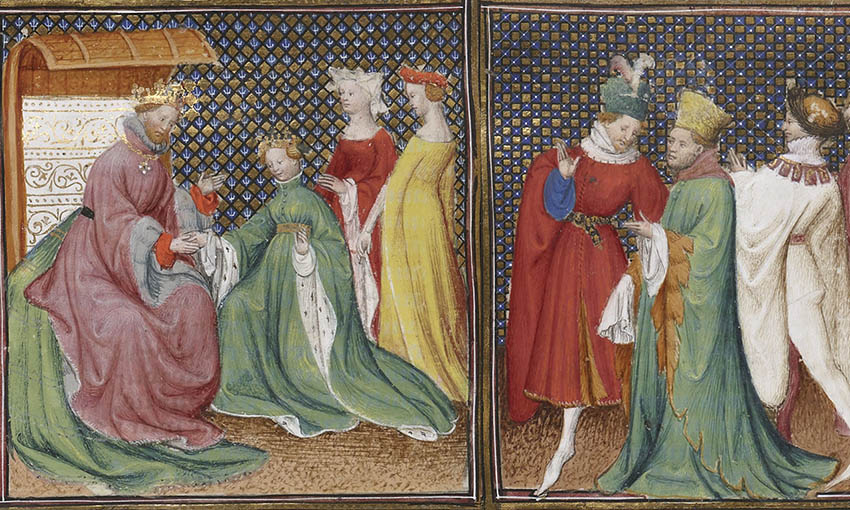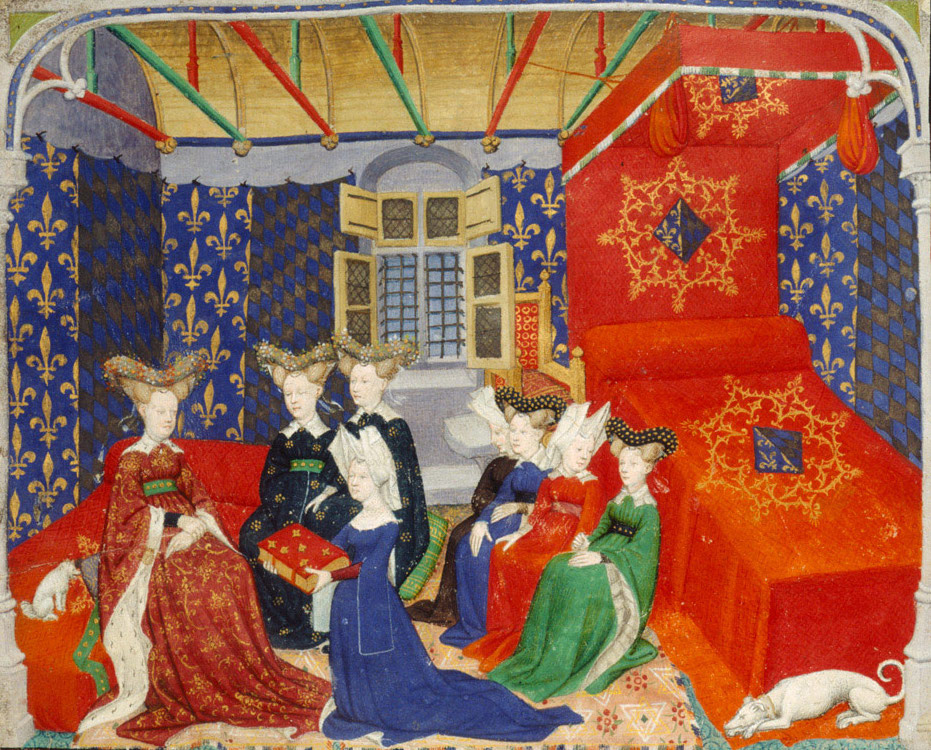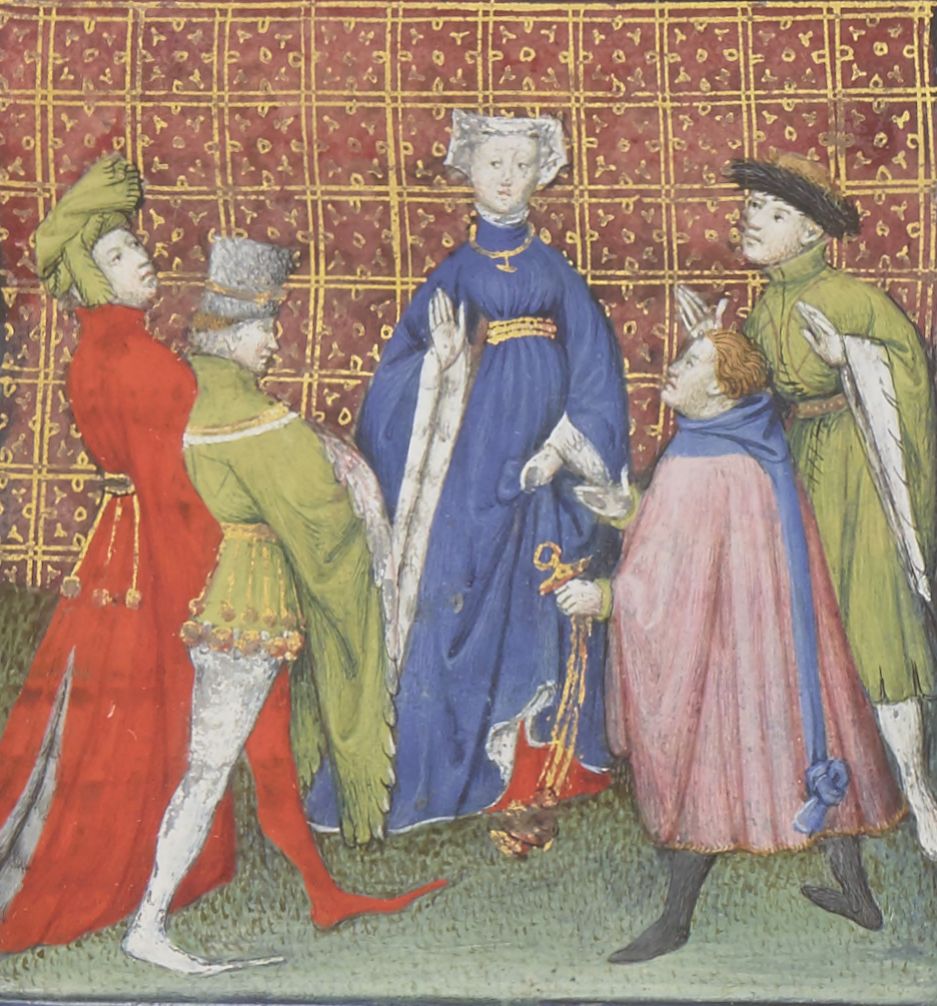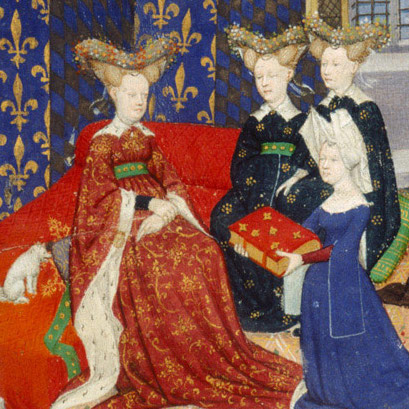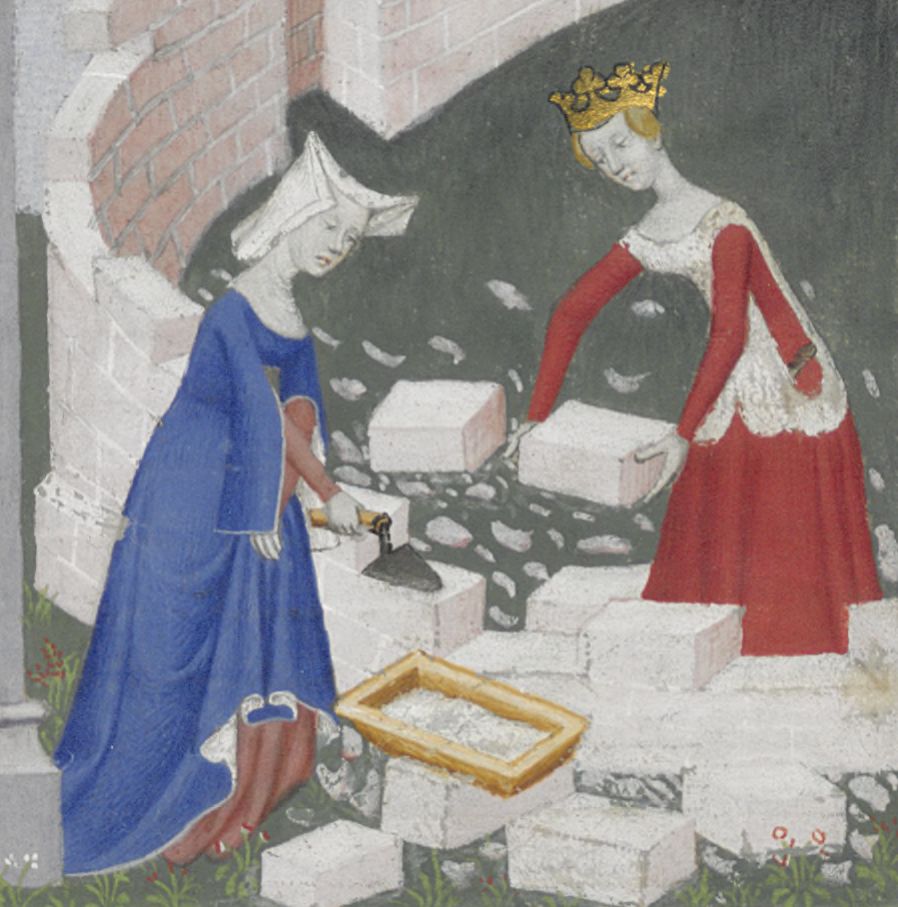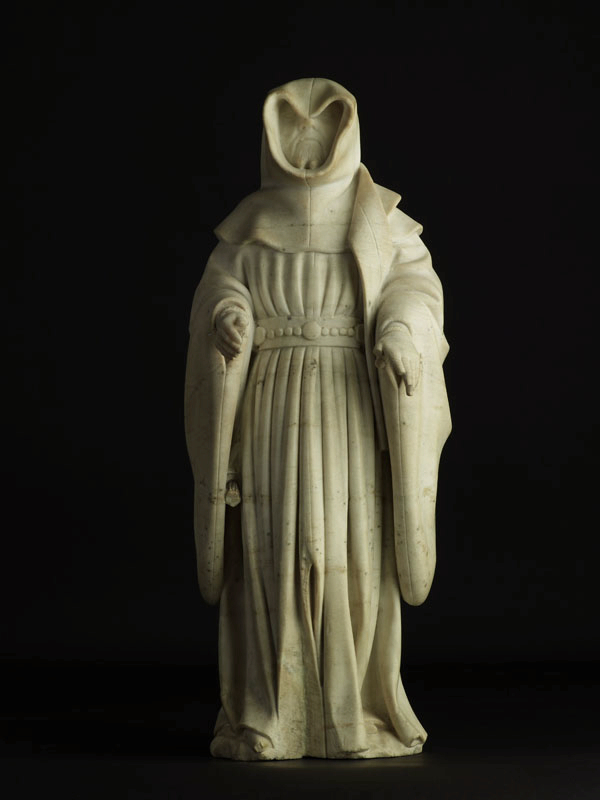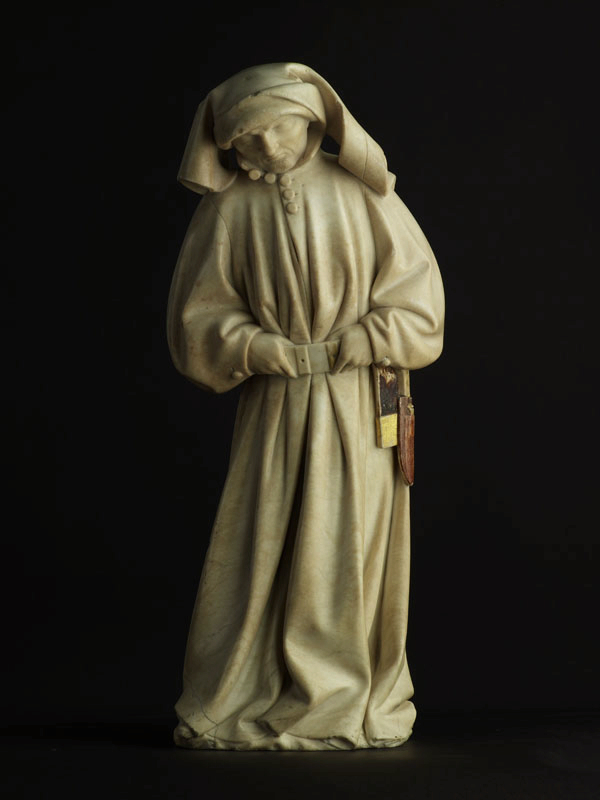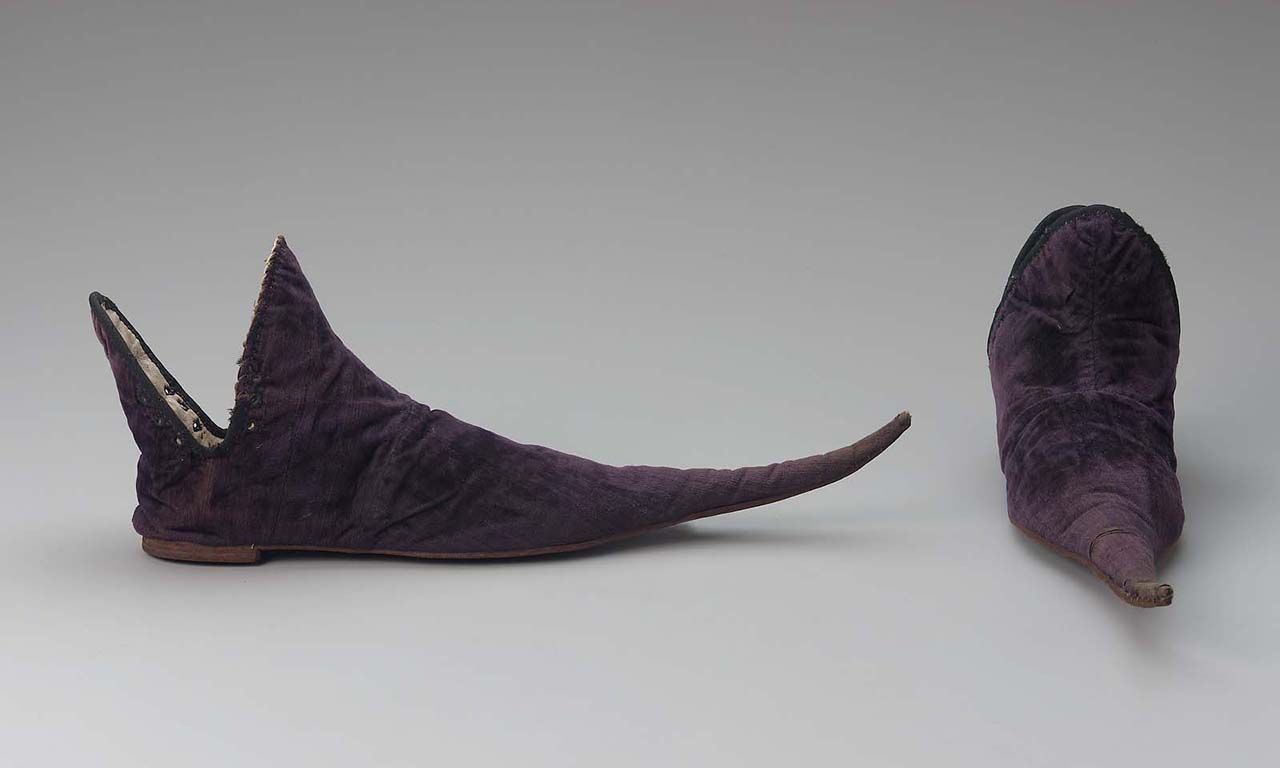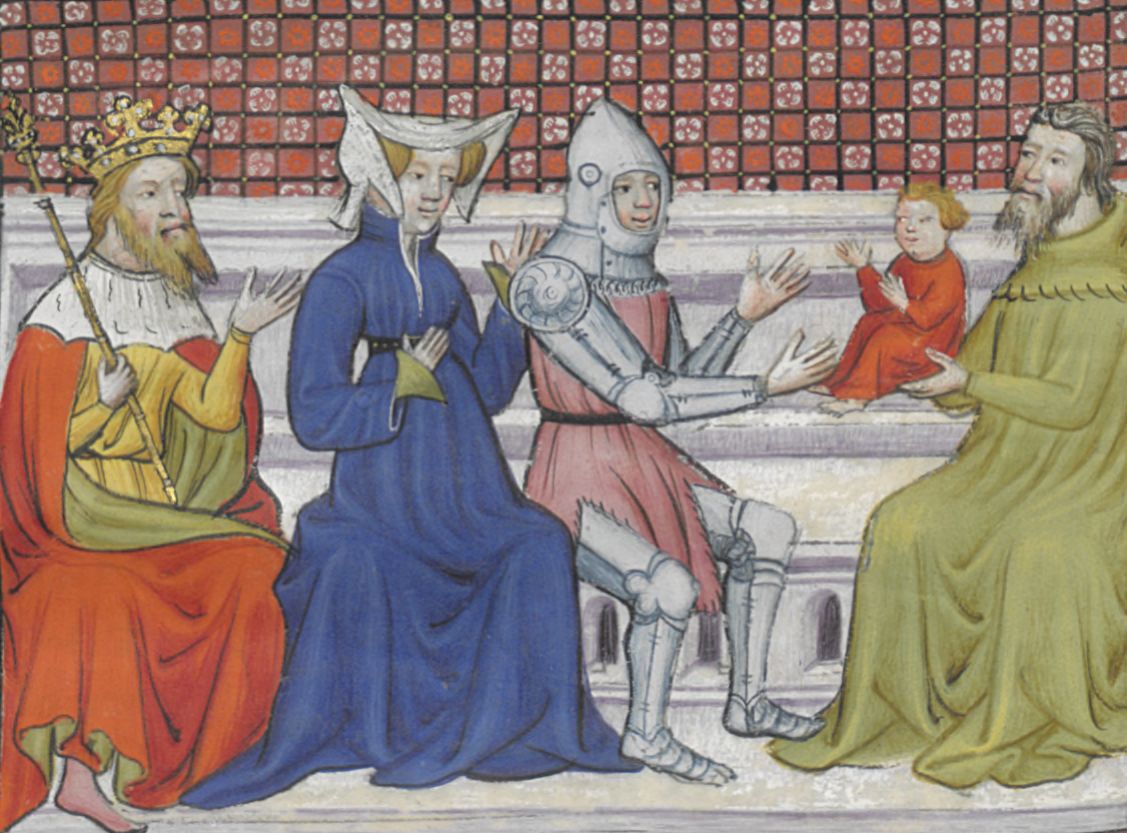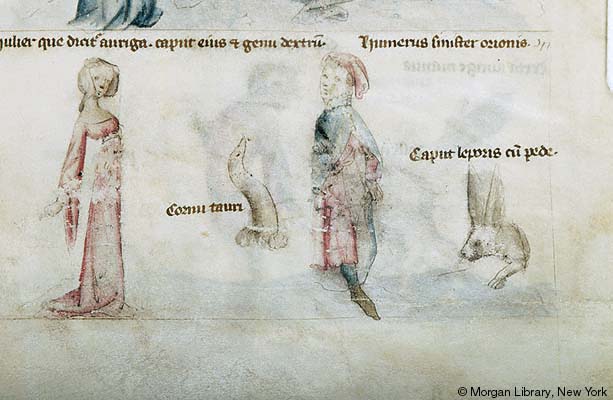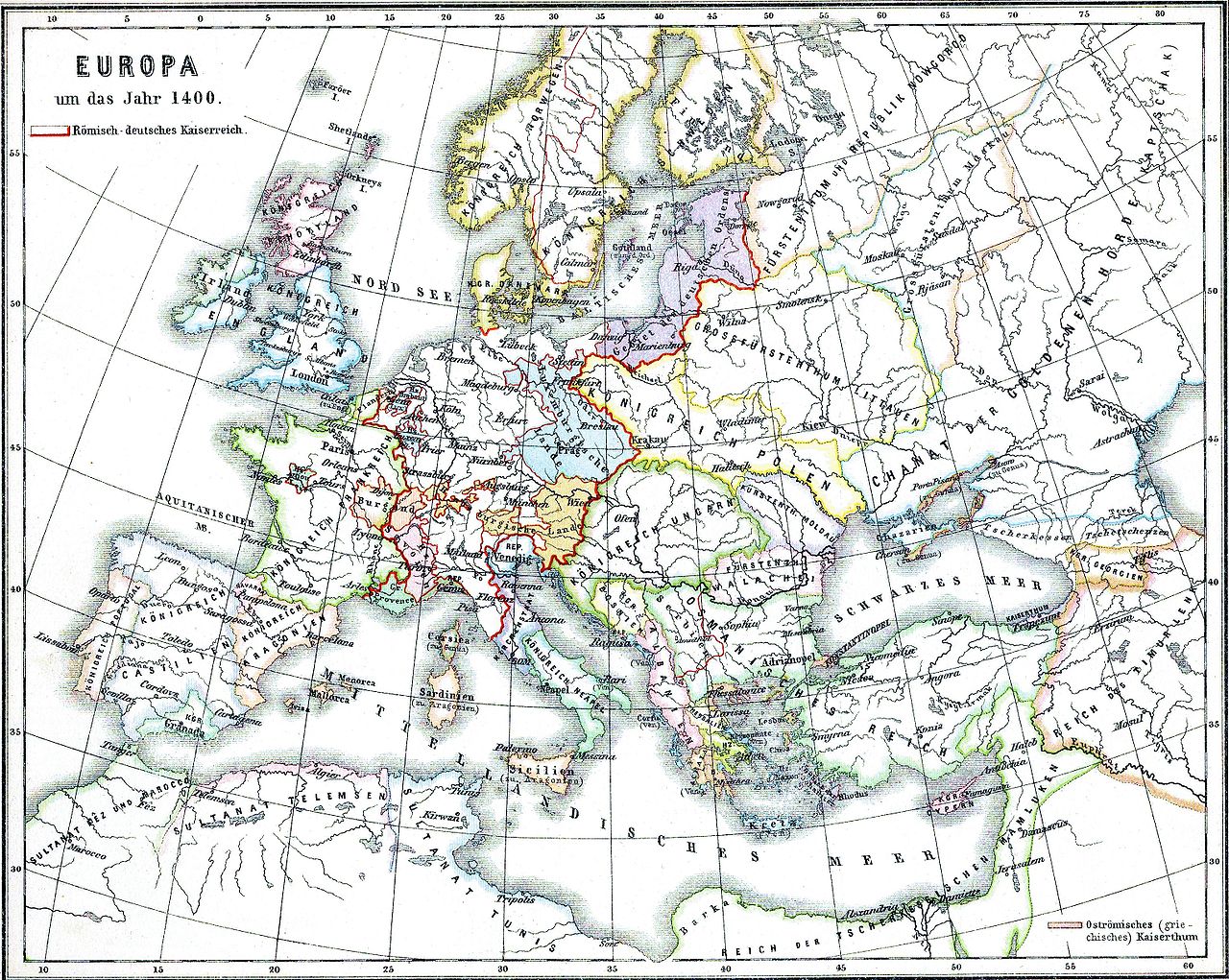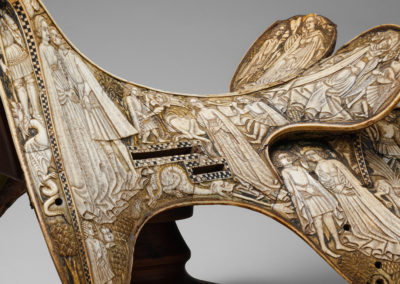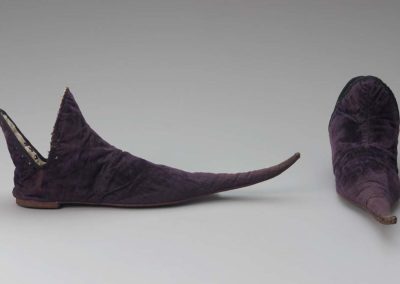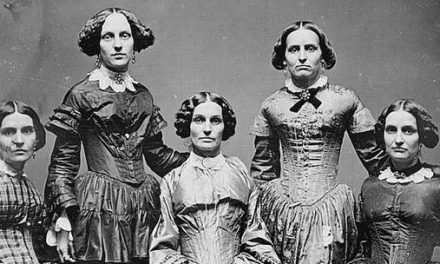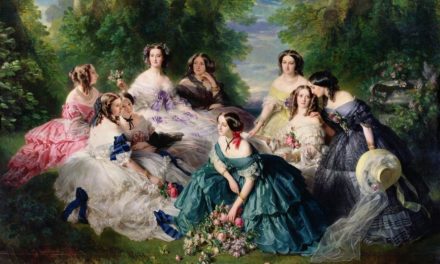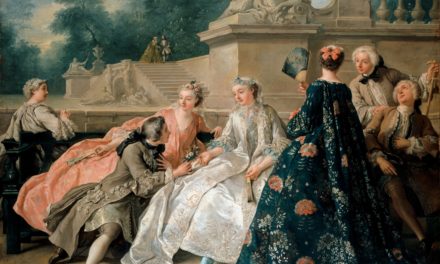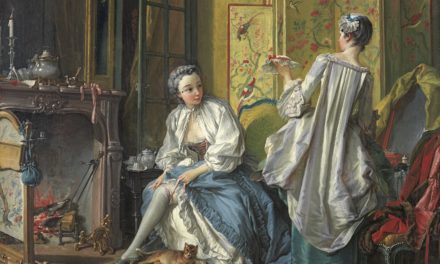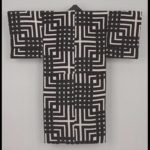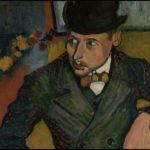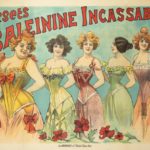OVERVIEW
In the first years of the war-torn fifteenth century, fashion was a battleground where rulers and courtiers lay claim to power with the display of luxury textiles, elaborate dagging and fanciful personal emblems. Throughout the decade, the fashions launched at the court of France influenced the rest of Europe. In England, Germany and Italy, sumptuary laws intent on preserving distinctions between nobles and commoners signal the wealth of the middle class and their increased ability to participate in fashion.
Womenswear
A linen chemise was the common foundation of all women’s dress, with only the quality of the fabric distinguishing an aristocrat from a peasant. This basic undergarment extended well below the knee, and had sleeves extending past the elbow; the neckline, probably drawn together with a drawstring, might be low and wide, mirroring the low necklines seen on the next layer of the costume, the côte-hardie (English kirtle, Italian cotta) (Boucher 198). Continuing a trend beginning in the mid-1300s, the côte-hardie was tightly fitted through the bodice, whether lacing in the front, at one or both sides, or at the center back. The sleeves too were usually fitted, lacing at the wrist. The skirt of the côte-hardie was as full as the bodice was tight; it could be constructed with gores inserted at the sides and at the center back and front (Fransen, Østergärd, Nørgaard, Nordtorp-Madson). As in the 1300s, women in this decade could layer one côte-hardie over another, in which case the upper côte-hardie often had elbow-length sleeves to reveal the longer sleeve of the one below.
Many sources, such as the scene depicting Reason leading five women into the author Christine de Pizan’s allegorical city of women (Fig. 1) show a fashionable flourish to this style: a strip of fabric hanging from the back of the sleeve of the upper côte-hardie, called a tippet (Van Buren and Wieck 318). Tippets could be just a few inches long, or they could extend the full length of the garment, trailing behind the wearer as she walked and fluttering with every gesture. Côte-hardies were typically made of wool, in a wide range of quality and cost, from undyed homespun to the smoothest, softest products of Flemish mills, dyed and finished in Italy. Silk, made in Italy or Spain, was accessible only to the very rich. Woven fabrics that blended silk with wool were more affordable (Piponnier and Mane 88). Linen was used to line the côte-hardie and reinforce its tight fit. The lining of a woman’s côte-hardie is revealed in the right wing of Rogier van der Weyden’s mid-fifteenth-century Saint Columba Altarpiece, now in the Alte Pinachotek in Munich.
Fig. 1 - Master of the Cité des Dames. "Reason Leads Five Sibyls into the City of Ladies," Cité des Dames by Christine de Pizan, 1400-1410. Paris: Bibliothèque nationale de France, MS fr. 607 (fol. 31v). Source: BNF Gallica
The next layer of a woman’s costume was determined by her wealth and social status. If she was able to participate in fashion, she would wear a houppelande rather than a traditional mantle or cape as her outer garment. Van Buren and Wieck define the houppelande as “a full outer garment worn by men and women” (307). Although the garment could look very different depending on its materials and decoration, most houppelandes had high necklines and long sleeves. Some buttoned partly down the front (Fig. 2) while others had side or back closures. Women’s houppelandes were always full-length; to emphasize luxury, they were sometimes made extra-long, puddling around a woman’s feet in front and extending into a train in back. The sleeves of the houppelande, in this decade, were most often in the bombard style, narrow at the shoulder and opening into a wide funnel that could extend the length of the garment. So fashionable were these sleeves that côte-hardies too were made with bombards. The extravagance of the style was decried by Christine de Pizan:
“And isn’t it a great outrage, even a silly thing, that which a grown tailor in Paris told the other day, that he had made for an ordinary lady living in the Gâtinois a côte-hardie into which he put five Paris ells of large-measured Brussels cloth, which trails a good three quarters (of an ell) on the ground, and into its bombard sleeves, which hang all the way to the feet?” (Pizan 159).
Although women were criticized more for their fashions than men, voluminous houppelandes with bombard sleeves were worn by both sexes (Piponnier and Mane 77-79). The edges of women’s sleeves, however, were generally not decorated with dagging, defined as “ornamental shapes of cloth cut or inserted in the hem of a garment” (Van Buren and Wieck 302). One of the hallmarks of this decade in men’s fashion, dagging added appreciably to the cost of a garment. Inventories and other documents suggest that garments made for women generally cost less, and that women spent less on their clothing than men (Pipponier and Mane 77).
Some expenses were obligatory, dictated by the requirements of rank. A queen, princess, or aristocrat at court would need a ceremonial wardrobe as well as a fashionable one. Court ceremonies preserved garments that dated back a century or more, such as the sideless surcôte (Fig. 1) and the ermine-lined trained cape. Following a custom that dated back to the 1300s, high-ranking court officials were also expected to make regular gifts called liveries to the members of their household. Liveries could take the form of lengths of cloth or finished garments and had the effect of dressing a lady’s attendants and servants in her chosen colors and styles (Piponnier and Mane 133-135). In 1401, to celebrate the birth of her daughter Catherine, Isabeau de Bavière, the Queen of France, gave all the ladies of her household a livery of blue wool (Evans 39). Two years later, she gave the women who worked in the royal nursery houppelandes of gray wool (Evans 54).
Fig. 2 - Master of the Cité des Dames. "Christine de Pizan presents a collection of her works to the Queen of France, Isabeau de Bavière," The Book of the Queen by Christine de Pizan, ca. 1410-1414. Parchment. London: British Library, Harley MS 4431. Source: British Library
Women’s most important accessories were headdresses, which were of two main types, the bourrelet and the wired veil. Both had a common foundation in the hairstyle called “a pair of temples,” because the hair was piled into two cones over the temples to form a horned shape (Van Buren and Wieck 317-318). Fine silk hairnets, pins, and caps variously called coifs (Van Buren and Wieck 302) or howves (Van Buren 308) held the hair in place. A woman could top her hairstyle with a bourrelet, a circular roll of fabric that would settle into the horned shape, held in place by pins and wires, or she could drape a fine linen veil over a structure of wire or whalebone (Evans 56). These alternative styles can be seen in figure 2. Both had the desired effect of enlarging the apparent size of the head, an effect heightened by severely plucking the eyebrows and hairline. The bourrelet could complement a woman’s complexion with colorful fabric further decorated with embroidery, studded with jewels, or trimmed with feathers or fur. The simpler wired veil, on the other hand, drew attention to delicate facial features and fashionable pallor. Although these elaborate headdresses attracted criticism from the first of the century’s religious reformers, they continued to grow in size during the decade (Van Buren and Wieck 110).
The court of France remained the center of fashion for both men and women. Christine de Pizan complained that French fashions changed too fast, as opposed to more stable Italian fashions (Scott 132). In 1401 the city of Bologna sought to curb women’s consumption of luxury fabrics and pursuit of the latest trends, like bombard sleeves. Women would have to register garments made of silk velvet and silk brocaded with gold and silver and pay a fee for the right to continue wearing them. In just two days, 210 garments were registered by 131 women. The law limited the width of sleeves to four feet, and their length could not extend past the wearer’s hand. The wives and daughters of knights and of lawyers and doctors were allowed to have wider sleeves, however (Scott 125). Critics of fashion argued that it led to wasteful expenditure and encouraged sinful vanity, while sumptuary laws suggest that there was widespread anxiety about wealth in the hands of “ordinary” middle class commoners, those without professional status, who were seen as a threat to the traditional social order (Piponnier and Mane 86).
Fig. 3 - Master of the Couronnement de la Vierge. "Solomon Receiving the Queen of Sheba," Grande Bible historiale, ca. 1395-1401. Paris: Bibliothèque nationale de France, BnF MS fr. 159 (fol. 289v). Source: BnF Gallica
Fig. 4 - Giovanni Boccaccio (Italian, 1313-1375). "The Woman Named Venus Adored by her Lovers," Des cleres et nobles femmes, ca. 1401-1500. Paris: Bibliothèque nationale de France, MS fr. 12420 (fol. 15). Source: BNF Gallica
Fashion Icon: Isabeau de Bavière (1370-1435)
Fig. 1 - Master of the Cité des Dames. "Christine de Pizan presents a collection of her works to the Queen of France, Isabeau de Bavière," The Book of the Queen by Christine de Pizan, ca. 1410-1414. Parchment. London: British Library, Harley MS 4431. Source: British Library
Fig. 2 - Parisian court workshop. Virgin and Child in an Arbor with Child Saints Shrine, ca. 1403-1404. Gold and enamel. Altötting: House Pope Benedict XVI Treasury and Pilgrimage Museum. Source: Wikipedia
Fig. 3 - Master of the Cité des dames. "Building the City of Ladies," Cité des Dames by Christine de Pizan, ca. 1400-1410. Paris: Bibliothèque nationale de France, BnF MS fr. 607 (fol. 2r). Source: BNF Gallica
Isabeau de Bavière (1370-1435) (Fig. 1) had been Queen of France for fifteen years and well established as a leader of fashion when the fifteenth century began. A Bavarian princess married to King Charles VI in 1385, when both were young teenagers, she wielded considerable power after 1392, when the King suffered the first of his frequent attacks of mental illness (Adams 210). During these periods, the Queen acted as Regent for her sons, the Dauphin Charles, who died in 1401 at the age of eight, and Louis, who succeeded him as Dauphin (Adams 154). Deadly struggles for power within the royal family and the ongoing 100 Years’ War with the English made her role extremely challenging. This context helps us to appreciate how she used fashion to craft an image and reinforce her claim to royal power.
Descriptions of her garments include a white silk velvet cape embroidered diagonally with gold cord strung with pearls and motifs that combined the King’s emblem of the broom plant with her own emblem, the pimpernel (Evans 39). Broom and pimpernel were also mingled on a côte-hardie of white wool with very full bombard sleeves that she wore in 1401 (Evans 53). She also had a gold belt in the form of thirty-two broom flowers set with rubies and sapphires, with broom pods in green enamel (Evans 55).
Isabeau was said to love jewelry and was an early patron of the technique of ronde-basse enamel on gold. An outstanding example is known as The Little Golden Horse Shrine (Fig. 2), given by Isabeau to the King as a New Year’s present in 1404. She was credited with introducing styles, such as the bourrelet headdress, that were still dominant during this decade (Evans 55). Though English and Burgundian chroniclers sought to blacken Isabeau’s reputation, Christine de Pizan praised her as a
“very redoubtable princess, powerful lady, born at a lucky hour” (Langdon Forhan 68).
In the 1405 illuminated manuscript of de Pizan’s Cité des Dames, the Queen who helps the author to build the city of women (Fig. 3) wears the ermine-trimmed sideless surcôte over a côte-hardie that Isabeau would have worn at court ceremonies. In a later manuscript, a collection of de Pizan’s works that Isabeau commissioned, she is shown in her bedroom, decorated with hangings embroidered with the French fleur-de-lys, with her ladies-in-waiting (Fig. 2 in womenswear above). The ladies evidently take their fashion cues from the Queen (Fig. 1), who wears the richest houppelande of red silk velvet decorated with gold, with the widest, longest bombard sleeves lined with ermine, and the tallest temple hairstyle crowned with the largest bourrelet. A few years later, the headdresses had grown even taller; a chronicler claimed that ladies had to turn their heads and bend down to clear the doorways at the Château de Vincennes, the Queen’s favorite residence (Van Buren and Wieck 12).
Menswear
Men’s fashion during this decade provided a rich spectacle of color, pattern and ornament, but fashion remained the privilege of the few. The vast majority of men continued to wear the woolen tunics and capes of previous centuries over plain linen shirts and drawers (Piponnier and Mane 87). Since dyed woolens were now less expensive, men of the lower classes began to dress more colorfully (Piponnier and Mane 88) but they would never be mistaken for men of fashion, who wore different garments as well as more luxurious materials.
The doublet or pourpoint (from the French verb pourpoincter, to pierce through or quilt) had already replaced the loose-fitting, knee-length tunic for upper-class men in the mid-1300s (Van Buren and Wieck 314). A fitted garment made of at least two layers of cloth, often padded or quilted, the doublet developed alongside plate armor as necessary protection for the body under a breastplate (Van Buren and Weick 2). Tailors followed the lead of armorers and conceived of the body as an assemblage of separately articulated parts. This segmented body became the ideal fashionable body (Newton 2-3). Whether a man wore armor over his doublet or not, its shape bore the stamp of armor and thus shared in the aristocratic prestige of knighthood.
The doublets of the first decade of the fifteenth century were distinguished by their high standing collars, by the increasing use of laces rather than buttons to fasten the center front closure, and by the placement of a belt at the natural waistline rather than on the hips (Evans 47-50). Often the sleeves would be made in the most fashionable styles (Fig. 1). From left to right, these noblemen wear a red houppelande in the mid-calf “bastard” length, with bombard sleeves; a full-length, fur-lined houppelande in green, also with bombard sleeves; a white doublet with deep poke sleeves and parti-colored white and red hose; and a blue doublet with poke sleeves, with green hose, under a pink, fur-lined garnache cape.
Fig. 1 - Master of the Couronnement de la Vierge. "A Princely Audience," Grande Bible historiale, ca. 1395-1401. Paris: Bibliothèque nationale de France, BnF MS fr. 159 (fol. 289v). Source: BnF Gallica
Fig. 2 - Master of the Couronnement de la Vierge. "Solomon Receiving the Queen of Sheba," Grande Bible historiale, ca. 1395-1401. Paris: Bibliothèque nationale de France, BnF MS fr. 159 (fol. 289v). Source: BnF Gallica
Early fifteenth-century doublets were also more likely to be made of silk rather than wool (Piponnier and Mane 68). Since doublets were quite short, barely covering the torso, tailors made the hose longer (Boucher 195). In the early fifteenth century hose were still made out of woven cloth, fitted with a seam at the center back (Evans 48). They were typically made of wool, in colors and patterns to match or contrast with the doublet. Often one leg would contrast with the other (parti-coloring) as seen in figure 1. Color schemes were dictated by heraldry and related livery uniforms, or by personal taste (Piponnier and Mane 135). The King of France Charles VI had hundreds of pairs of hose, including over 130 with attached leather soles (Evans 48). Doublet and hose were connected by means of laces (Van Buren and Wieck 14).
The outer garment worn over doublet and hose, usually a houppelande, was the focus of men’s fashion. Men’s houppelandes were constructed with gores widening to the hemline, which varied from full-length to mid-calf (a style called “bastard length”) to knee-length or above (Van Buren and Wieck 307). Short houppelandes were called haincelins, after Charles VI’s court jester, Haincelin Coq (Piponnier and Mane 68). In this decade the most fashionable houppelandes were full-length with a high standing collar and long funnel-shaped bombard sleeves, as worn by King Solomon in the 1400 Bible Historiale (Fig. 2). An alternative sleeve style was the bag or poke sleeve that narrowed at the wrist (Fig. 1). The most expensive and luxurious houppelandes were made of the new Italian silk velvet weaves. When Charles VI’s uncle Philip the Bold, Duke of Burgundy, died in 1404, the inventory of his wardrobe was “full of dresses of lovely brocade” and “new stuffs such as plush with gold loops” (Evans 44). Of the forty-one houppelandes listed, only one was of wool. Most were of silk damask, satin, or velvet, with four made of cloth-of-gold, including one lined in sable that had been a gift from his brother Jean de Berry. Most of the houppelandes were full-length, many lined in ermine or other furs and decorated with the Duke’s emblems and his and his wife’s monograms embroidered in pearls and other gemstones. More than half of the Duke’s houppelandes were red, considered the color of strength and power, with green, the color of youthful vigor, a secondary favorite (Van Buren and Wieck 8).
Fig. 3 - Master of the Cité des Dames. "Christine de Pizan presents her book to Louis, Duke of Orléans," The Book of the Queen by Christine de Pizan, ca. 1410-1414. London: British Library, MS 4431 (fol. 95r). Source: British Library
Leaders of fashion at the French court dressed in particular colors and motifs that they claimed as their own. The King’s four colors were white, green, scarlet red, and black (Evans 40). In addition to his emblem of the broom flower, the King adopted the motif of the knotty branch, a symbol of strength and resolve first devised by his brother Louis, the Duke of Orléans. The brothers both had red satin houppelandes embroidered full-length with criss-crossing knotty branches (Evans 41). The Duke of Orléans favored black; among his personal emblems were the wolf and the porcupine (Scott 126; Evans 42). In one of Christine de Pizan’s works (Fig. 3), he is portrayed wearing a blue houppelande, the upper part embroidered with golden wolves and a gold necklace with a pendant in the shape of a porcupine. Two of his attendants wear similar necklaces. The choice of personal emblems was not governed by any rule, but they were clearly used to send political messages. As the Burgundian branch of the royal family clashed with the Orléans, the next Duke of Burgundy, Jean the Fearless, adopted the motif of the carpenter’s plane, a tool capable of smoothing out the knotty branch (Evans 41). The custom of granting livery gifts extended these colors and motifs to a prince’s entire household of courtiers and servants.
Fig. 4 - Claus Sluter (Dutch, 1340-1405). Mourner No. 36 from the tomb of Philip the Bold, 1404-1406. Alabaster; height: 40 cm. Musée des Beaux-Arts de Dijon, CA 1416 No. 36. Attribution of the General Council of the Côte d'Or, 1827. Source: MBA Collections
Fig. 5 - Claus Sluter (Dutch, 1340-1405). Crying No. 34 tomb of Philip the Bold, 1404-1406. Alabaster; height: 39.8 cm. Musée des Beaux-Arts de Dijon, CA 1416 No. 34. Attribution of the General Council of the Côte d'Or, 1827. Source: MBA Collections
Claus Sluter’s sculptures of mourners on the tomb of Philip the Bold show us the contrast between the dress of a court official, the Grand Steward (Fig. 4) and a middle-class clerk (Fig. 5). The Grand Steward wears a long houppelande of what appears to be smooth wool, cut with flaring gores that are pleated and held in place by a studded belt at the natural waistline; the clerk’s houppelande also appears to be made of fine wool, but it is narrower in cut and looser-fitting, and his belt is placed at a lower waistline, which was old-fashioned in this decade. Hanging from his belt is a case to hold his writing instruments. His sleeves are loose-fitting but of modest proportions, compared to the deep poke sleeves of the Grand Steward. The two mourners also differ in their headgear, which are two versions of the chaperon, or hood, derived from earlier centuries. The Grand Steward’s is the traditional mourning chaperon à barbute, large enough to rest on the shoulders like a capelet, and deep enough to cast the face into shadow. According to contemporary records, such chaperons were issued to all members of the household after the Duke’s death (Van Buren and Wieck 108). The clerk, however, was not a member of the Duke’s entourage; his chaperon was in a style that could be seen on the streets of the Flemish cities that furnished Burgundy with its wealth. Alternatives to the chaperon included the barret, a hat with a low crown and an up-turned brim, and a hat with a tall, flaring crown. In figure 6 both hat styles can be seen along with two chaperons, one wound around the head in the typical turban style, and one completely un-done, resting around the neck with its long tie, called the cornet (Van Buren and Wieck 300) trailing down the wearer’s back. Straw hats had begun to be imported from Italy in the late 1300s and were still considered fashionable novelties (Fig. 3). Underneath their headgear, men wore their hair in two styles — the “wing-cut,” with flaring sides, long enough to cover the ears, or the newer “bowl cut” where the hair was shaved all around the head, except for the crown (Van Buren and Wieck 311).
Fig. 6 - Giovanni Boccaccio (Italian, 1313-1375). "The Woman Named Venus Adored by her Lovers," Des cleres et nobles femmes, ca. 1401-1500. Paris: Bibliothèque nationale de France, MS fr. 12420 (fol. 15). Source: BNF Gallica
Fig. 7 - Maker unknown (French). Pair of poulaine (or crakow ) shoes, 15th Century. Silk plain weave covered with silk velvet, silk binding tape, silk thread, metal nails, painted leather lining, and leather; 16.5 x 10.6 x 45 cm (6 1/2 x 4 3/16 x 17 11/16 in). Boston: Museum of Fine Arts, 44.572a-b. The Elizabeth Day McCormick Collection. Source: MFA
Men who could afford it wore as much jewelry as women. Heavy gold necklaces with pendants were framed by the high necklines of doublets and houppelandes. Gold belts with vertical chains dangling golden bells (Fig. 6) may have been associated with the Burgundian cause, since the bell was among the Duke of Burgundy’s emblems (Evans 42). Gipsers were purses hung from men’s belts (Van Buren and Wieck 104).
Poulaines (Fig. 7), the extremely pointy shoes that were already fashionable in the last decades of the 1300s, continued to be men’s most eccentric fashion accessory in this decade. In addition to shoes and boots with points stiffened with wood or bone (Van Buren and Wieck 314), the style also affected hose made with attached soles (Fig. 6). Poulaines, along with long houppelandes and unwieldy bombard sleeves, made it difficult for the fashionable man to move.
In addition to the cost of clothing made of luxury fabrics and furs, and of the most fashionable accessories, high-ranking aristocrats needed traditional ceremonial garments for the most formal occasions. For men this meant a tunic (cotte) instead of a doublet, and a garnache, a slit, sideless cape, as an outer garment. A King’s ceremonial attire consisted of a cotte, surcôte, garnache and the manteau à parer, a trained, ermine-lined cape (Evans 43).
CHILDREN’S WEAR
A child in the early fifteenth century would be swaddled in infancy and then dressed in loose-fitting tunics, of wool layered over linen, just like the vast majority of adults (Fig. 1). In order to forge alliances, aristocratic and royal children would be betrothed and married very young, and dressed in fashions that were only slightly simpler than those of adults (Fig. 2). In 1405, Philip, the eight-year-old heir to the duchy of Burgundy, became engaged to Michelle de Valois, the nine-year-old daughter of King Charles VI and Isabeau de Bavière. The young couple were married four years later (Vaughan 8). Once engaged, children could be sent to the court of their family by marriage, to complete their upbringing in the local customs, manners and fashions.
Fig. 1 - Artist unknown. "Merlin Shows Sir Bors the Infant Galahad," Arthurian Romances, 1401-1425. Paris: Bibliothèque nationale de France, MS 3480, (fol. 359v). Source: BnF Gallica
Fig. 2 - Artist unknown. "Sphaera Graeca," Liber astrologiae by Abü Ma'ashar, ca. 1403. New York: Morgan Library and Museum, MS M.785 (fol. 9r). Purchased in 1935. Source: Morgan Library and Museum
References:
- Adams, Tracy. The Life and Afterlife of Isabeau of Bavaria. Baltimore: Johns Hopkins University Press, 2010. http://www.worldcat.org/oclc/699724902
- Boucher, François. 20,000 Years of Fashion: The History of Costume in the West. New York: Abrams, 1987. http://www.worldcat.org/oclc/16773978
- Evans, Joan. Dress in Medieval France. Oxford: Clarendon Press, 1952. http://www.worldcat.org/oclc/578147259
- Fransen, Lilli, Else Østergärd, Anna Nørgaard and Shelly Nordtorp-Madson. Medieval Garments Reconstructed: Norse Clothing Patterns. Aarhus, Denmark: Aarhus University Press, 2011. http://www.worldcat.org/oclc/904298327
- Langdon Forhan, Kate. The Political Theory of Christine de Pizan. London: Taylor & Francis, 2017. http://www.worldcat.org/oclc/1003910191
- Newton, Stella Mary. Fashion in the Age of the Black Prince. Totowa, NJ: Rowman and Littlefield, 1980. http://www.worldcat.org/oclc/640086432
- Piponnier, Françoise and Perrine Mane, Dress in the Middle Ages. Tr. by Catherine Beamish. New Haven: Yale University Press, 1997. http://www.worldcat.org/oclc/800164394
- Pizan, Christine de. Le livre des trois vertus, by Charity Cannon Willard and Eric Hicks. Paris, 1989. http://www.worldcat.org/oclc/708311661
- Scott, Margaret. Fashion in the Middle Ages. Los Angeles: J. Paul Getty Museum, 2011. http://www.worldcat.org/oclc/741734274
- Van Buren, Anne and Roger S. Wieck. Illuminating Fashion: Dress in the Art of Medieval France and the Netherlands. New York: Pierpont Morgan Library, 2011. http://www.worldcat.org/oclc/931839789
- Vaughan, Richard. Philip the Good: The Apogee of Burgundy. Woodbridge [UK]: Boydell Press, 2004. http://www.worldcat.org/oclc/974138639
Historical Context
Map of Europe in the 1400s. Source: Wikipedia
Events:
- 1401 – Death of the eight-year-old heir to the French throne, the Dauphin Charles; he is succeeded by his brother Louis.
- 1403 – In the independent duchy of Savoy, the first version of the sumptuary laws known as the Statutes of Savoy are passed, expressing the fear that excess luxury will offend God.
- 1404 – Death of Duke Philip the Bold of Burgundy, succeeded by Jean the Fearless.
- 1405 – Christine de Pizan’s book Cité des Dames (City of Ladies), celebrating virtuous women in history and in the present day, is completed.
- 1407 – King Charles VI’s younger brother Louis, Duke of Orléans, is assassinated in Paris on the orders of his cousin Jean the Fearless, Duke of Burgundy.
Timeline Entries
Primary/Period Sources
Resources for Fashion History Research
To discover primary/period sources, explore the categories below.
Have a primary source to suggest? Or a newly digitized periodical/book to announce? Contact us!
Digitized Primary/Period Sources
Secondary Sources
Also see the 15th-century overview page for more research sources… or browse our Zotero library.

